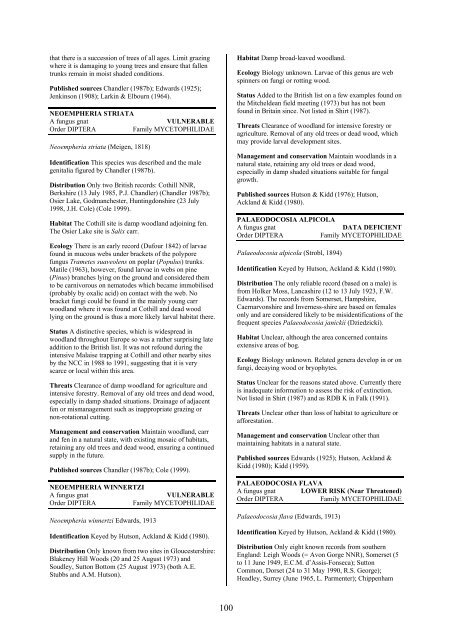Part 2: Nematocera and Aschiza not dealt with by Falk (1991) - JNCC
Part 2: Nematocera and Aschiza not dealt with by Falk (1991) - JNCC
Part 2: Nematocera and Aschiza not dealt with by Falk (1991) - JNCC
You also want an ePaper? Increase the reach of your titles
YUMPU automatically turns print PDFs into web optimized ePapers that Google loves.
that there is a succession of trees of all ages. Limit grazing<br />
where it is damaging to young trees <strong>and</strong> ensure that fallen<br />
trunks remain in moist shaded conditions.<br />
Published sources Ch<strong>and</strong>ler (1987b); Edwards (1925);<br />
Jenkinson (1908); Larkin & Elbourn (1964).<br />
NEOEMPHERIA STRIATA<br />
A fungus gnat<br />
VULNERABLE<br />
Order DIPTERA<br />
Family MYCETOPHILIDAE<br />
Neoempheria striata (Meigen, 1818)<br />
Identification This species was described <strong>and</strong> the male<br />
genitalia figured <strong>by</strong> Ch<strong>and</strong>ler (1987b).<br />
Distribution Only two British records: Cothill NNR,<br />
Berkshire (13 July 1985, P.J. Ch<strong>and</strong>ler) (Ch<strong>and</strong>ler 1987b);<br />
Osier Lake, Godmanchester, Huntingdonshire (23 July<br />
1998, J.H. Cole) (Cole 1999).<br />
Habitat The Cothill site is damp woodl<strong>and</strong> adjoining fen.<br />
The Osier Lake site is Salix carr.<br />
Ecology There is an early record (Dufour 1842) of larvae<br />
found in mucous webs under brackets of the polypore<br />
fungus Trametes suaveolens on poplar (Populus) trunks.<br />
Matile (1963), however, found larvae in webs on pine<br />
(Pinus) branches lying on the ground <strong>and</strong> considered them<br />
to be carnivorous on nematodes which became immobilised<br />
(probably <strong>by</strong> oxalic acid) on contact <strong>with</strong> the web. No<br />
bracket fungi could be found in the mainly young carr<br />
woodl<strong>and</strong> where it was found at Cothill <strong>and</strong> dead wood<br />
lying on the ground is thus a more likely larval habitat there.<br />
Status A distinctive species, which is widespread in<br />
woodl<strong>and</strong> throughout Europe so was a rather surprising late<br />
addition to the British list. It was <strong>not</strong> refound during the<br />
intensive Malaise trapping at Cothill <strong>and</strong> other near<strong>by</strong> sites<br />
<strong>by</strong> the NCC in 1988 to <strong>1991</strong>, suggesting that it is very<br />
scarce or local <strong>with</strong>in this area.<br />
Threats Clearance of damp woodl<strong>and</strong> for agriculture <strong>and</strong><br />
intensive forestry. Removal of any old trees <strong>and</strong> dead wood,<br />
especially in damp shaded situations. Drainage of adjacent<br />
fen or mismanagement such as inappropriate grazing or<br />
non-rotational cutting.<br />
Management <strong>and</strong> conservation Maintain woodl<strong>and</strong>, carr<br />
<strong>and</strong> fen in a natural state, <strong>with</strong> existing mosaic of habitats,<br />
retaining any old trees <strong>and</strong> dead wood, ensuring a continued<br />
supply in the future.<br />
Published sources Ch<strong>and</strong>ler (1987b); Cole (1999).<br />
NEOEMPHERIA WINNERTZI<br />
A fungus gnat<br />
VULNERABLE<br />
Order DIPTERA<br />
Family MYCETOPHILIDAE<br />
Neoempheria winnertzi Edwards, 1913<br />
Identification Keyed <strong>by</strong> Hutson, Ackl<strong>and</strong> & Kidd (1980).<br />
Distribution Only known from two sites in Gloucestershire:<br />
Blakeney Hill Woods (20 <strong>and</strong> 25 August 1973) <strong>and</strong><br />
Soudley, Sutton Bottom (25 August 1973) (both A.E.<br />
Stubbs <strong>and</strong> A.M. Hutson).<br />
Habitat Damp broad-leaved woodl<strong>and</strong>.<br />
Ecology Biology unknown. Larvae of this genus are web<br />
spinners on fungi or rotting wood.<br />
Status Added to the British list on a few examples found on<br />
the Mitcheldean field meeting (1973) but has <strong>not</strong> been<br />
found in Britain since. Not listed in Shirt (1987).<br />
Threats Clearance of woodl<strong>and</strong> for intensive forestry or<br />
agriculture. Removal of any old trees or dead wood, which<br />
may provide larval development sites.<br />
Management <strong>and</strong> conservation Maintain woodl<strong>and</strong>s in a<br />
natural state, retaining any old trees or dead wood,<br />
especially in damp shaded situations suitable for fungal<br />
growth.<br />
Published sources Hutson & Kidd (1976); Hutson,<br />
Ackl<strong>and</strong> & Kidd (1980).<br />
PALAEODOCOSIA ALPICOLA<br />
A fungus gnat<br />
DATA DEFICIENT<br />
Order DIPTERA<br />
Family MYCETOPHILIDAE<br />
Palaeodocosia alpicola (Strobl, 1894)<br />
Identification Keyed <strong>by</strong> Hutson, Ackl<strong>and</strong> & Kidd (1980).<br />
Distribution The only reliable record (based on a male) is<br />
from Holker Moss, Lancashire (12 to 13 July 1923, F.W.<br />
Edwards). The records from Somerset, Hampshire,<br />
Caernarvonshire <strong>and</strong> Inverness-shire are based on females<br />
only <strong>and</strong> are considered likely to be misidentifications of the<br />
frequent species Palaeodocosia janickii (Dziedzicki).<br />
Habitat Unclear, although the area concerned contains<br />
extensive areas of bog.<br />
Ecology Biology unknown. Related genera develop in or on<br />
fungi, decaying wood or bryophytes.<br />
Status Unclear for the reasons stated above. Currently there<br />
is inadequate information to assess the risk of extinction.<br />
Not listed in Shirt (1987) <strong>and</strong> as RDB K in <strong>Falk</strong> (<strong>1991</strong>).<br />
Threats Unclear other than loss of habitat to agriculture or<br />
afforestation.<br />
Management <strong>and</strong> conservation Unclear other than<br />
maintaining habitats in a natural state.<br />
Published sources Edwards (1925); Hutson, Ackl<strong>and</strong> &<br />
Kidd (1980); Kidd (1959).<br />
PALAEODOCOSIA FLAVA<br />
A fungus gnat LOWER RISK (Near Threatened)<br />
Order DIPTERA<br />
Family MYCETOPHILIDAE<br />
Palaeodocosia flava (Edwards, 1913)<br />
Identification Keyed <strong>by</strong> Hutson, Ackl<strong>and</strong> & Kidd (1980).<br />
Distribution Only eight known records from southern<br />
Engl<strong>and</strong>: Leigh Woods (= Avon Gorge NNR), Somerset (5<br />
to 11 June 1949, E.C.M. d’Assis-Fonseca); Sutton<br />
Common, Dorset (24 to 31 May 1990, R.S. George);<br />
Headley, Surrey (June 1965, L. Parmenter); Chippenham<br />
100
















